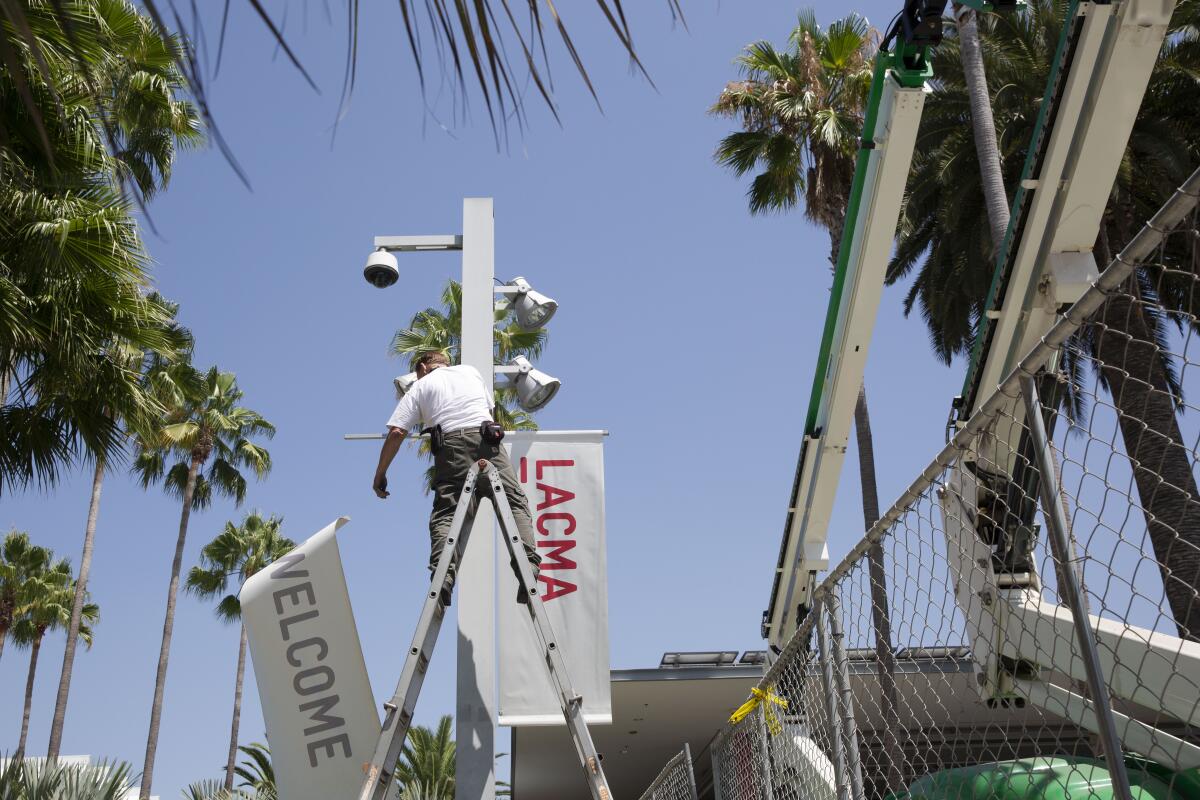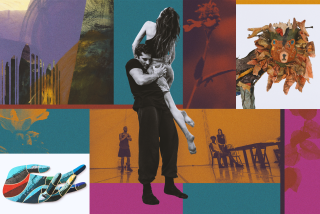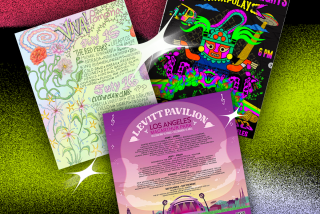Essential Arts: The impenetrable Music Center gets an accessible new look
The Music Center gets a nip and tuck, and a critic visits a half-empty LACMA. I’m Carolina A. Miranda, staff writer at the Los Angeles Times, with the week’s essential art news — and Japanese death poetry.
Music Center redo
When architect Welton Becket designed the Music Center in 1964, he placed his trio of performing arts buildings on a broad plaza that hovers 10 feet above Grand Avenue. One critic likened the aloof complex to “the deck of an aircraft carrier.” But a redesign of the center’s plaza by Rios Clementi Hale Studios, led by partner Bob Hale, promises to make the Music Center more accessible. “We really saw the ability to create access for everybody,” Hale tells me. “But also providing opportunities that didn’t exist.”
Says Music Center president and CEO Rachel Moore: “We shouldn’t be a white castle on the hill.”

I chat with KCRW’s Madeleine Brand and Frances Anderton about the plaza’s redo.
Times food writer Jenn Harris reports on the rotating chef program at Abernethy’s, the new sit-down restaurant that will open there Sept. 5.
Side note: I am very much a fan of the semicircular floor pattern in Go Get Em Tiger, the plaza’s new cafe.

Plus: the Music Center will open the plaza with a series of free public events, including a cumbia night, a performance by the Los Angeles Master Chorale and a splash bash for families.
The museum is open, sort of
Speaking of 1960s cultural temples: Mary McNamara has a column on LACMA‘s somnolent state. In preparation for construction, the museum has closed the Art of the Americas building, the Hammer building, the Pavilion for Japanese Art, the Bing Theater and most of the Ahmanson — an experience for which it is still charging full admission. “Blaring signs saying ‘LACMA is open’ is just false advertising,” writes McNamara. “Much of it isn’t. So for heaven’s sake, just say so.”

Classical notes
An update on the Plácido Domingo harassment inquiry: The Times’ Makeda Easter reports that the investigation will be led by Debra Wong Yang from the firm of Gibson, Dunn & Crutcher, a former U.S. Attorney who led the investigation into the behavior of USC medical school dean Carmen A. Puliafito.
Times classical music critic Mark Swed, meanwhile, is in Europe, reporting on happenings in Austria and Germany.
He caught a performance of Mozart’s “Idomeneo,” directed by Peter Sellars, at the Salzburg Festival and a show of Yuval Sharon‘s refreshed “Lohengrin” at the Bayreuth Festival. “To see these productions back to back revealed not only how much L.A. has developed into an individual and leading voice in operatic thinking,” he writes, “but also how provincial (or is it afraid?) we are about taking advantage of it.”
At Bayreuth, director Tobias Kratzer updated Wagner’s “Tannhäuser” with an anarchist gang and a drag queen. It received rapturous applause from the audience. Less rapturous: the reception given Russian conductor Valery Gergieve, who was booed. “It seemed that Gergiev’s favored status in Vladimir Putin’s Russia was the real source of the animosity,” writes Swed, who interviewed Gergiev.
Contributor Catherine Womack profiles Laura Karpman, a composer bringing attention to the work of other female composers. On Thursday, she premiered a piece that incorporated melodic elements by Anita Owen, a little-known turn-of-the-20th-century musician. “It’s about amplifying women,” she says.

In the galleries
At Gagosian gallery, “Desert Painters of Australia Part II” offers “an exciting conclusion to an unusually lively summer gallery season,” writes Times art critic Christopher Knight. The show, which gathers paintings by indigenous artists such as Naata Nungurrayi, most of whom hail from Australia’s Northern Territory, features works that “are masterful contemporary paintings, plain and simple.”
Susan Mogul‘s current show at As Is L.A. consists of a series of objects that tell the story of her connection with her mother, many of them clusters of Midcentury Modern objects that serve as “humorous little meditations,” writes contributing reviewer Sharon Mizota.
Mizota wins for best lead this week for her review about the Armory Center‘s show on Club Scum: “Where can you paint your face like a beauty queen with a raw, bloody, monster’s maw? Sculpt a vulva on your bald head? Perform in a cow suit, complete with udder, and feel completely at home? At Club Scum, of course.”
On the stage
In Jiehae Park‘s “Hannah and the Dread Gazebo,” on view at the Fountain Theatre, a story of a young woman attempting to help her grandmother becomes a surreal family tale involving Korea’s origin myth and the heavily fortified border with North Korea. “That’s a lot to chew on in a play that runs roughly 90 minutes without intermission and that has its narrator routinely step out of the frame to explain the method of her dizzying storytelling,” writes Times theater critic Charles McNulty.
Times film critic Kenneth Turan, in the meantime, reviews “Fiddler: A Miracle of Miracles,” an “engaging and enlightening documentary” that examines the history of the musical “Fiddler on the Roof,” along with its extensive reach. “This is especially ironic,” writes Turan, “given that when the original ‘Fiddler’ was trying to get produced, voices were loud and persistent that nobody was going to want to see it.”
“Frankenstein” has come to life at A Noise Within in Pasadena. Playwright Nick Dear‘s 2011 adaption “rescues Mary Shelley‘s creation from the stereotypes of innumerable grunting, lumbering movie monsters,” writes contributor Philip Brandes, with a monster that quotes Milton.
Luis J. Rodriguez, author of the critically acclaimed “Always Running: La Vida Loca, Gang Days in L.A.,” has helped adapt his memoir into a work of theater that will premiere at Casa 0101 on Aug. 31. “I can’t put the whole book on stage,” he tells contributor Patrick J. Kinger. “I wanted to focus on the mentor’s dilemma and the patience and persistence required.”
Blood and sex in the ’80s
Filmmaker Hari Sama has created an ode to his youth and the 1980s Mexico City art scene in “This Is Not Berlin,” which lands in L.A. theaters this weekend. I spoke with Sama about the period in which young upstarts such as Gabriel Orozco and Teresa Margolles, now well-known international artists, did wild installations and performances. “Everything was so forbidden that it made it made it feel special,” he tells me. “There was this real underground, this creative explosion.”
Film critic Justin Chang reviews the film: The movie “opens with a quote from Proust and a blast of raucous misfit energy: It’s like a promise that we are about to see a memory broken open and poured out onscreen, raw and unfiltered.”
Ready for the weekend
Matt Cooper has his Weekend Picks, which include several gigs by Pink Martini and the Hollywood Bowl Orchestra at the Bowl.
Your support helps us deliver the news on culture — and this newsletter. Subscribe to the Los Angeles Times.
In other news...
— Curved hallways and half walls: schools are now being designed for mass shootings.
— How Snapchat reshaped the urban character of Venice Beach.
— Washington, D.C.’s Jefferson Memorial, which has been plagued by rain, bugs and a biofilm, is getting an $8.2-million freshening up.
— Speaking of D.C., Justin Davidson is diggin’ the new expansion for the Kennedy Center by Steven Holl.
— Novelist Alice Walker say that George Washington High School in San Francisco shouldn’t cover up its Victor Arnautoff mural.
— John Maloof, the collector who helped bring the work of street photographer Vivian Maier to light, has donated his trove of Maier images to the University of Chicago Library.
— Cuts to cultural budgets in Mexico have cast a pall on the art market there.
— Napa’s di Rosa Center for Contemporary Art has announced that it plans to sell most of its collection. The art community has responded with an open letter protesting the plan.
— “A Soldier’s Play,” the Pulitzer Prize-winning work by Charles Fuller, is heading to Broadway.
— “Apollo 11 — The Immersive Live Show” was supposed to travel from Pasadena to Orange County in October, but the production has been canceled.
And last but not least...
Maybe it’s the fires in the Amazon, but I’m feeling very into Japanese death poems.
More to Read
The biggest entertainment stories
Get our big stories about Hollywood, film, television, music, arts, culture and more right in your inbox as soon as they publish.
You may occasionally receive promotional content from the Los Angeles Times.







